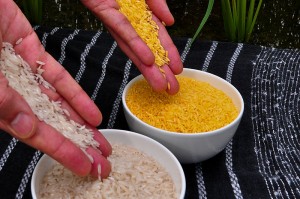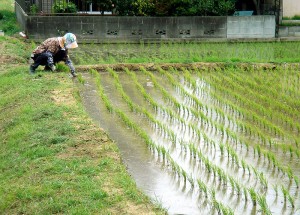 The Green Revolution of the 1960s and 1970s brought an array of agricultural technology that helped the world’s population almost double in size. The 21st century, however, brings a new set of challenges. A continually increasing population, the relative scarcity of fresh water and arable land, and the unpredictable climactic effects of global warming have put a great deal of stress on the world’s food supplies. The world’s population is expected to reach 9 billion by 2050 – scientists are scrambling to improve existing farming technologies in order to feed the planet while protecting its fragile ecosystems.
The Green Revolution of the 1960s and 1970s brought an array of agricultural technology that helped the world’s population almost double in size. The 21st century, however, brings a new set of challenges. A continually increasing population, the relative scarcity of fresh water and arable land, and the unpredictable climactic effects of global warming have put a great deal of stress on the world’s food supplies. The world’s population is expected to reach 9 billion by 2050 – scientists are scrambling to improve existing farming technologies in order to feed the planet while protecting its fragile ecosystems.
We currently feed the world’s population using technologies that are designed to produce large amounts of grains in the cheapest manner possible. Intensive monoculture (planting acres upon acres of the same kind of crop), genetic modification, continuous land use, irrigation, fertilizers and pesticides have made it possible to feed almost 7 billion people. Crop productivity has increased tremendously in the past 100 years –in 1900, American farmers produced about 40 bushels of corn per acre, while 21st century farmers can produce more than 150 bushels per acre. The percentage of farmers in the developed world has decreased, while food production continues to increase – in 1800, 90% of Americans were farmers. Today, less than 2% of Americans grow food for a living.
 Unfortunately, these astounding increases in productivity have come at a cost. About 40% of the world’s land is currently being used for agricultural purposes. Agriculture also uses 87% of the world’s easily accessible freshwater. intensive monoculture and continuous tilling devastates biodiversity, depletes the soil of nutrients and causes severe soil erosion. The widespread use of pesticides and fertilizers pollutes the air and water while sickening animals and humans alike. 30% of the world’s arable land has been degraded; meanwhile, global warming has produced unpredictable droughts and storms that have ruined harvests and sent food prices soaring.
Unfortunately, these astounding increases in productivity have come at a cost. About 40% of the world’s land is currently being used for agricultural purposes. Agriculture also uses 87% of the world’s easily accessible freshwater. intensive monoculture and continuous tilling devastates biodiversity, depletes the soil of nutrients and causes severe soil erosion. The widespread use of pesticides and fertilizers pollutes the air and water while sickening animals and humans alike. 30% of the world’s arable land has been degraded; meanwhile, global warming has produced unpredictable droughts and storms that have ruined harvests and sent food prices soaring.
The price of corn, rice, soybeans and other commodities has increased by almost 40% in the last year, prompting food riots in countries as diverse as Mexico and Yemen. The situation seems grim, but the state of the world’s food supply has not gone unnoticed. A combination of thoughtful policy, technological innovation and mindful eating will, hopefully, ensure our ability to feed the world’s growing population.
France, the leader of the G20 nations, recently called an emergency meeting to address rapidly rising food prices. A series of rapidly introduced policies will assist in stabilizing food prices and funding research programs to increase the productivity of wheat and rice farmers. The G20 will also lift restrictions on exporting food for humanitarian purposes and expedite the global response to food crises, ensuring that those who are hungry will be fed as quickly as possible.
Meanwhile, scientists are hard at work on varieties of drought-resistant wheat, flood-proof rice and new breeds of high-yield, high-nutrient crops. No-till agriculture and natural pest control are becoming increasingly efficient, offering hope for feeding the world’s population without ruining its land. At the grassroots level, the world’s growing numbers of vegetarians, vegans, organic consumers and locavores are drawing attention to the importance of conscious eating. Activists are asking hard-hitting questions about the world’s excess meat consumption and food waste in an era where almost 1 billion people go hungry every day. And they’re beginning to receive the attention they desire.
The world’s food situation isn’t the brightest, but there is hope within every stalk of wheat and grain of rice.


